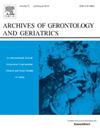Comparison of non-exercise physical activity and exercise habits for preventing frailty among community-dwelling older adults: A 7-year follow-up from the Kashiwa cohort study
IF 3.5
3区 医学
Q2 GERIATRICS & GERONTOLOGY
引用次数: 0
Abstract
Background
Engagement in non-exercise physical activities (NEPA) has a significant correlation with health. This study aimed to compare the impact of moderate-to-vigorous-intensity NEPA and exercise habit (EH) on frailty among community-dwelling older adults.
Methods
This study utilized data from the Kashiwa cohort study in Japan, with baseline assessments in 2014 with a 7-year follow ups (4.0 [2.0–7.0]). A total of 1,288 participants were included. Frailty was assessed using the Cardiovascular Health Study Index, NEPA through the Global Physical Activity Questionnaire, and EH via self-reported exercise engagement at each follow-up examination. Generalized estimating equations (GEE) and Cox regression analyses were used to estimate associations between NEPA, EH, and frailty.
Results
Compared to participants with no NEPA nor EH, those with NEPA only, with EH only, and with both showed significantly lower adjusted odds ratio (95 %CI) of frailty: 0.29 (0.16–0.52), 0.21 (0.11–0.41) and 0.21 (0.12–0.36). NEPA and EH at baseline were predictor variables for new-onset frailty during the 7-year follow-up period, with adjusted hazard ratios (95 % CI) of 0.55 (0.33–0.92) for NEPA only, 0.51 (0.29–0.90) for EH only, and 0.42 (0.25–0.70) for both. No significant differences were observed between the associations of NEPA and EH with frailty.
Conclusions
NEPA is associated with lower frailty risk in older adults, with a similar but non-additive effect to that of EH. These findings highlight the importance of NEPA for frailty prevention, particularly for those not engaged in formal exercise programs.
在社区居住的老年人中,非运动体育活动和运动习惯预防虚弱的比较:来自Kashiwa队列研究的7年随访。
背景:参与非运动性身体活动(NEPA)与健康有显著相关。本研究旨在比较中高强度NEPA和运动习惯(EH)对社区老年人身体虚弱的影响。方法:本研究使用来自日本Kashiwa队列研究的数据,于2014年进行基线评估,并进行7年随访(4.0[2.0-7.0])。共有1288名参与者被纳入调查。虚弱程度通过心血管健康研究指数进行评估,NEPA通过全球身体活动问卷进行评估,EH通过每次随访检查中自我报告的运动参与程度进行评估。使用广义估计方程(GEE)和Cox回归分析来估计NEPA、EH和脆弱性之间的关联。结果:与没有NEPA和EH的参与者相比,只有NEPA、只有EH和两者都有的参与者虚弱的校正优势比(95% CI)显著降低:0.29(0.16-0.52)、0.21(0.11-0.41)和0.21(0.12-0.36)。基线时NEPA和EH是7年随访期间新发虚弱的预测变量,仅NEPA的校正风险比(95% CI)为0.55(0.33-0.92),仅EH的校正风险比为0.51(0.29-0.90),两者的校正风险比为0.42(0.25-0.70)。NEPA和EH与虚弱之间没有显著差异。结论:NEPA与老年人较低的衰弱风险相关,与EH具有相似但非相加性的作用。这些发现强调了NEPA对于预防虚弱的重要性,特别是对于那些没有参加正式运动项目的人。
本文章由计算机程序翻译,如有差异,请以英文原文为准。
求助全文
约1分钟内获得全文
求助全文
来源期刊
CiteScore
7.30
自引率
5.00%
发文量
198
审稿时长
16 days
期刊介绍:
Archives of Gerontology and Geriatrics provides a medium for the publication of papers from the fields of experimental gerontology and clinical and social geriatrics. The principal aim of the journal is to facilitate the exchange of information between specialists in these three fields of gerontological research. Experimental papers dealing with the basic mechanisms of aging at molecular, cellular, tissue or organ levels will be published.
Clinical papers will be accepted if they provide sufficiently new information or are of fundamental importance for the knowledge of human aging. Purely descriptive clinical papers will be accepted only if the results permit further interpretation. Papers dealing with anti-aging pharmacological preparations in humans are welcome. Papers on the social aspects of geriatrics will be accepted if they are of general interest regarding the epidemiology of aging and the efficiency and working methods of the social organizations for the health care of the elderly.

 求助内容:
求助内容: 应助结果提醒方式:
应助结果提醒方式:


